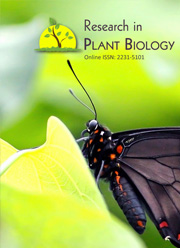In vitro regeneration of Lycopersicum esculentum Mill.
Keywords:
Callus induction, Plantlet regeneration, Shooting, RootingAbstract
An in vitro regeneration system for Lycopersicum esculentum variety CO2 wasdeveloped to produce transgenic plants. The transformation and regeneration protocol wasbased upon indirect organogenesis from seedling-derived explants method. Initially the seedwas inoculated in basal medium to produce aseptic explants. Callus were produced fromaseptic explants through use of MS medium supplemented with 2,4,Dichlorophenoxy aceticacid at various concentration ranges from 0.01-0.1 mg/l. Regeneration of callus was achievedwhen it is transferred to medium supplemented with 6-benzyl aminopurine, Indole aceticacid and Naphthalene acetic acid alone and in combination. Callus induction was observedon MS medium augmented with 0.1 mg/l 2,4-D. Calli which were separated from the primaryculture and subcultured on fresh medium containing MS supplemented with 0.6 mg/l NAAand 0.4 mg/l IAA also showed increased biomass. Regeneration of callus was achieved whenMS medium supplemented with 0.5 mg/l BAP. Regenerated plantlets having secondary andtertiary roots were considered to be fully regenerated and were transferred to plastic pots forhardening in a mixture containing Red soil sand and vermiculate.Downloads
Download data is not yet available.
Published
21-10-2013
How to Cite
Aishwarya, L., & Robinson, J. (2013). In vitro regeneration of Lycopersicum esculentum Mill. Research in Plant Biology, 3(5). Retrieved from https://updatepublishing.com/journal/index.php/ripb/article/view/2494
Issue
Section
Articles



 .
. 